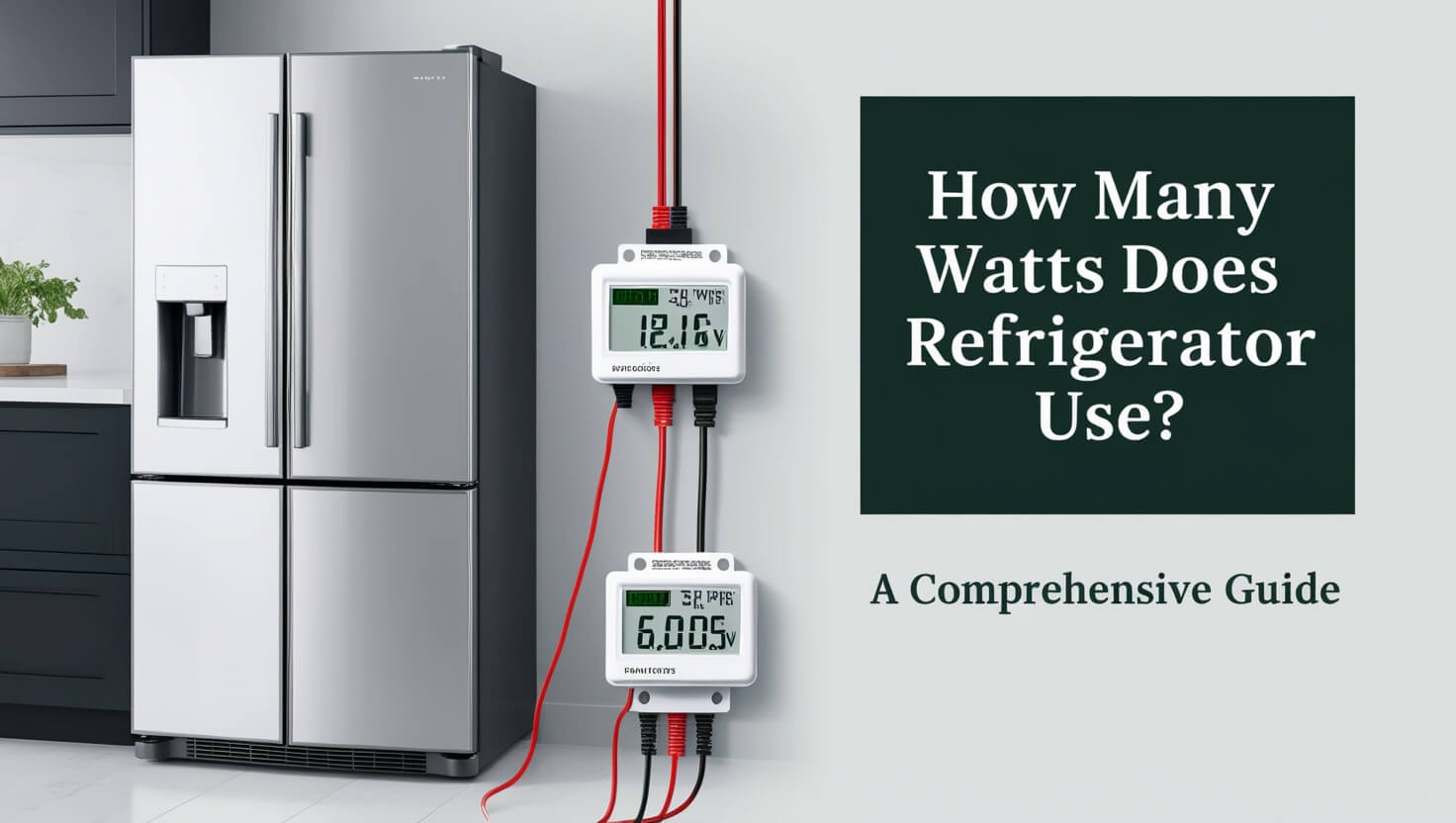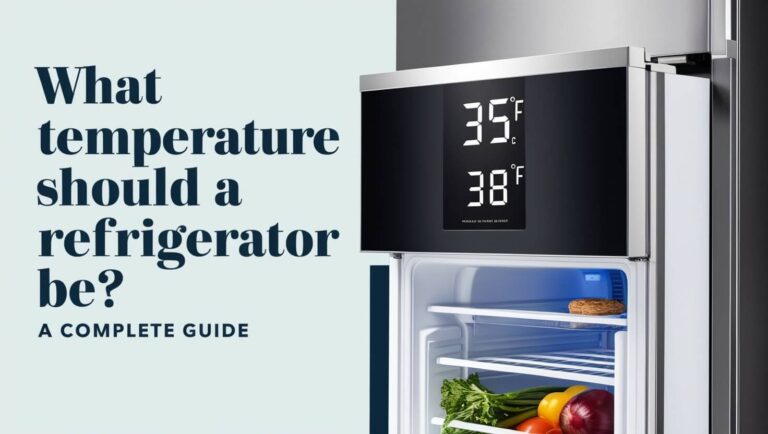How Many Watts Does a Refrigerator Use?

Refrigerators are essential appliances in our homes, working tirelessly to keep our food fresh and safe. But have you ever wondered how much electricity they consume? On average, a refrigerator uses between 100 to 400 watts of power, depending on its size, type, and efficiency. However, this number can vary widely based on several factors. In this guide, we’ll dive deep into the world of refrigerator power consumption, helping you understand exactly how many watts your fridge uses and how to optimize its energy efficiency.
Understanding Refrigerator Power Consumption
Before we delve into specific wattage numbers, it’s crucial to understand what watts are and why they matter when it comes to your refrigerator’s energy usage.
What Are Watts and Why Do They Matter?
Watts are a unit of power that measure the rate at which energy is consumed. When it comes to refrigerators, knowing the wattage helps you understand how much electricity your appliance is using and how it impacts your energy bills. The higher the wattage, the more power your refrigerator consumes.
Average Wattage of Different Refrigerator Types
Different types of refrigerators have varying power requirements. Here’s a quick overview:
- Mini fridges: 80-150 watts
- Standard top-freezer or bottom-freezer models: 100-800 watts
- Side-by-side refrigerators: 200-1000 watts
- French door refrigerators: 200-1200 watts
Keep in mind that these are average ranges, and the exact wattage can differ based on specific models and brands.
Factors Affecting Refrigerator Power Usage
Several factors influence how many watts a refrigerator uses:
- Size and capacity
- Age and efficiency
- Temperature settings
- Ambient room temperature
- Frequency of door openings
- Amount of food stored
Understanding these factors can help you make informed decisions about your refrigerator’s energy consumption.
Calculating Your Refrigerator’s Wattage
To determine exactly how many watts your refrigerator uses, you’ll need to do a bit of math. Don’t worry, though – it’s simpler than it sounds!
Finding Voltage and Amperage Ratings
First, locate the label on your refrigerator that displays its electrical information. This label is usually found inside the fridge, on the door frame, or at the back of the appliance.
Look for two important numbers:
- Voltage (V): Typically 120V in the United States
- Amperage (A): This can vary, but is often between 3 to 6 amps
Using the Wattage Formula
Once you have these numbers, use this simple formula to calculate the wattage:
Watts = Volts x Amps
For example, if your refrigerator runs on 120 volts and draws 5 amps, the calculation would be:
120V x 5A = 600 watts
However, it’s important to note that this calculated wattage represents the maximum power draw. In reality, refrigerators don’t constantly operate at this level.
Energy Guide Labels and What They Mean
Most refrigerators come with an EnergyGuide label, which provides valuable information about the appliance’s energy consumption. This yellow label typically shows:
- Estimated yearly electricity use in kilowatt-hours (kWh)
- Estimated yearly operating cost
- Energy consumption range compared to similar models
These labels can be incredibly helpful in understanding your refrigerator’s efficiency and comparing it to other models on the market.
Daily, Monthly, and Annual Power Consumption
Now that we know how to calculate wattage, let’s explore how this translates into daily, monthly, and annual energy usage.
How Many Watts Does a Refrigerator Use Per Day?
To estimate daily power consumption, we need to consider that refrigerators don’t run at full power constantly. Instead, they cycle on and off to maintain the set temperature. A common rule of thumb is that refrigerators run about one-third of the time.
Using our previous example of a 600-watt refrigerator:
600 watts x 1/3 = 200 watts average power draw
To calculate daily usage:
200 watts x 24 hours = 4,800 watt-hours or 4.8 kilowatt-hours (kWh) per day
Monthly Energy Usage of Refrigerators
To estimate monthly usage, simply multiply the daily consumption by the number of days in a month:
4.8 kWh x 30 days = 144 kWh per month
Yearly Power Consumption and Costs
For annual consumption, multiply the monthly usage by 12:
144 kWh x 12 months = 1,728 kWh per year
To calculate the cost, multiply this by your electricity rate. If we assume an average rate of $0.14 per kWh:
1,728 kWh x $0.14 = $241.92 per year
Remember, these are estimates, and your actual usage and costs may vary based on your specific refrigerator and electricity rates.
Comparing Refrigerator Types and Their Wattage
Different types of refrigerators have varying power requirements. Let’s take a closer look at how many watts each type typically uses.
Mini Fridge Power Consumption
Mini fridges are compact and generally use less power than full-sized refrigerators. They typically consume between 80 to 150 watts.
Daily usage: 80-150 watts x 1/3 x 24 hours = 640-1,200 watt-hours or 0.64-1.2 kWh per day Annual usage: 0.64-1.2 kWh x 365 days = 233.6-438 kWh per year
Standard Top-Freezer and Bottom-Freezer Models
These common household refrigerators usually use between 100 to 800 watts, depending on their size and efficiency.
Daily usage: 100-800 watts x 1/3 x 24 hours = 800-6,400 watt-hours or 0.8-6.4 kWh per day Annual usage: 0.8-6.4 kWh x 365 days = 292-2,336 kWh per year
Side-by-Side Refrigerator Wattage
Side-by-side models tend to use more energy due to their larger size and dual-door design. They typically consume between 200 to 1000 watts.
Daily usage: 200-1000 watts x 1/3 x 24 hours = 1,600-8,000 watt-hours or 1.6-8 kWh per day Annual usage: 1.6-8 kWh x 365 days = 584-2,920 kWh per year
French Door Refrigerator Energy Usage
French door refrigerators are often the most energy-intensive, using between 200 to 1200 watts.
Daily usage: 200-1200 watts x 1/3 x 24 hours = 1,600-9,600 watt-hours or 1.6-9.6 kWh per day Annual usage: 1.6-9.6 kWh x 365 days = 584-3,504 kWh per year
These figures illustrate how refrigerator type can significantly impact power consumption. When choosing a new refrigerator, consider not just the upfront cost but also the long-term energy expenses.
The Impact of Refrigerator Wattage on Your Electric Bill
Understanding how many watts your refrigerator uses is crucial because it directly affects your electricity costs. Let’s explore this impact in more detail.
Percentage of Household Energy Use
Refrigerators typically account for about 5-10% of a home’s total energy consumption. This might not seem like much, but over time, it adds up to a significant portion of your electric bill.
Estimating Costs Based on Wattage
To estimate how much your refrigerator costs to run, use this formula:
(Wattage x Hours used per day) / 1000 = Daily kWh Daily kWh x Electricity rate = Daily cost Daily cost x 365 = Annual cost
For example, if you have a 600-watt refrigerator running for 8 hours a day (remember, they cycle on and off), and your electricity rate is $0.14 per kWh:
(600 x 8) / 1000 = 4.8 kWh per day 4.8 x $0.14 = $0.672 per day $0.672 x 365 = $245.28 per year
Energy Star Ratings and Potential Savings
Energy Star certified refrigerators use about 15% less energy than non-certified models. This can lead to significant savings over the life of the appliance.
For instance, if an Energy Star refrigerator saves 15% on our previous example:
$245.28 x 0.15 = $36.79 savings per year
Over a 10-year lifespan, that’s nearly $370 in savings, not accounting for potential increases in electricity rates.
Factors Influencing Refrigerator Power Consumption
Several factors affect how many watts a refrigerator uses. Understanding these can help you make informed decisions about your appliance use and potentially reduce your energy consumption.
Size and Capacity
Larger refrigerators generally use more power. However, a full-sized refrigerator that’s appropriately sized for your household may be more efficient than running multiple smaller units.
Age and Efficiency
Older refrigerators tend to be less energy-efficient. Models manufactured before 1990 can use up to 1,400 kWh of electricity per year, while modern Energy Star certified models use less than half that amount.
Temperature Settings and Climate
The colder you set your refrigerator, the harder it has to work and the more power it consumes. The ideal temperature for a refrigerator is between 35°F and 38°F (1.7°C to 3.3°C).
Your home’s climate also plays a role. In warmer environments, your refrigerator needs to work harder to maintain its internal temperature, using more watts in the process.
Usage Patterns and Door Openings
Frequent door openings allow cold air to escape, making your refrigerator work harder to maintain its temperature. This increases power consumption. Similarly, storing hot foods directly in the refrigerator can temporarily increase its power usage as it works to cool them down.
Tips to Reduce Your Refrigerator’s Power Consumption
Now that we understand how many watts a refrigerator uses and what factors influence its energy consumption, let’s explore some ways to reduce that power usage.
Optimal Temperature Settings
Set your refrigerator to the ideal temperature range of 35°F to 38°F (1.7°C to 3.3°C). The freezer should be set to 0°F (-18°C). Using a thermometer to check these temperatures can help ensure you’re not overcooling and wasting energy.
Proper Maintenance and Cleaning
Regular maintenance can help your refrigerator run more efficiently:
- Clean the condenser coils at least twice a year
- Check and replace door seals if they’re worn or damaged
- Defrost manual-defrost refrigerators and freezers regularly
A well-maintained refrigerator uses fewer watts to operate.
Strategic Placement in Your Kitchen
Where you place your refrigerator can affect its energy consumption:
- Keep it away from heat sources like ovens, dishwashers, or direct sunlight
- Ensure proper ventilation around the refrigerator, especially at the back
- If possible, place it against an interior wall rather than an exterior one
Efficient Loading and Organization
How you use your refrigerator can impact its power consumption:
- Don’t overfill the refrigerator – good air circulation is important for efficiency
- Let hot foods cool before refrigerating them
- Cover liquids and wrap foods to prevent moisture from making the compressor work harder
- Know what you want before opening the door to minimize the time it’s open
By following these tips, you can potentially reduce the number of watts your refrigerator uses, leading to lower energy bills.
Powering Refrigerators with Alternative Energy Sources
As we become more conscious of our energy consumption, many people are exploring alternative ways to power their appliances, including refrigerators.
Solar Panels and Refrigerators
Solar panels can be an excellent way to offset the energy consumption of your refrigerator. Here’s a quick calculation to understand how many solar panels you might need:
- Calculate your refrigerator’s daily energy usage in kWh
- Divide this by the daily output of a typical solar panel (around 1.5 kWh per day for a 300-watt panel)
For example, if your refrigerator uses 4.8 kWh per day:
4.8 kWh / 1.5 kWh = 3.2 panels
This means you’d need about 3 to 4 solar panels to fully power your refrigerator.
Using Inverters for Refrigerators
If you’re using solar power or another DC power source, you’ll need an inverter to convert DC to AC for your refrigerator. When choosing an inverter, remember:
- The inverter should handle at least 20% more than your refrigerator’s starting wattage
- Pure sine wave inverters are best for refrigerators as they provide clean, stable power
Off-Grid Refrigeration Solutions
For off-grid living, there are specialized DC refrigerators designed to run directly on solar power without an inverter. These are typically more expensive upfront but can be more efficient in the long run.
Understanding Refrigerator Starting Wattage vs. Running Wattage
When discussing how many watts a refrigerator uses, it’s important to distinguish between starting wattage and running wattage.
What is Starting Wattage?
Starting wattage, also known as surge wattage, is the power required to start the refrigerator’s compressor. This is typically 3 to 4 times higher than the running wattage and lasts for just a fraction of a second.
For example, a refrigerator with a running wattage of 200 watts might have a starting wattage of 600 to 800 watts.
Continuous Power Requirements
Running wattage, or continuous power, is what the refrigerator uses during normal operation. This is the figure we’ve been discussing throughout this article when we talk about how many watts a refrigerator uses.
Understanding both these figures is crucial when:
- Sizing a generator to run your refrigerator during a power outage
- Calculating the capacity needed for solar power systems
- Choosing the right inverter for off-grid setups
Future Trends in Refrigerator Energy Efficiency
As technology advances, refrigerators are becoming increasingly energy-efficient. Let’s look at some trends that are shaping the future of refrigerator power consumption.
Technological Advancements
Several innovations are helping to reduce the number of watts refrigerators use:
- Improved compressor technology
- Better insulation materials
- More efficient LED lighting
- Advanced defrosting systems
These advancements mean that modern refrigerators often use significantly fewer watts than older models.
Smart Refrigerators and Power Management
Smart refrigerators are entering the market with features designed to optimize power usage:
- Adaptive defrost cycles that run only when necessary
- Temperature zones that can be individually controlled
- Smartphone apps that alert you if the door is left open
- Integration with smart home systems for better energy management
While these refrigerators might have higher upfront costs, their advanced features can lead to lower power consumption over time.
Ending Thoughts
Understanding how many watts a refrigerator uses is crucial for managing your home’s energy consumption and costs. While the average refrigerator uses between 100 to 400 watts, this can vary widely based on factors like size, type, age, and usage patterns.
By choosing an energy-efficient model, maintaining it properly, and using it wisely, you can significantly reduce your refrigerator’s power consumption. Whether you’re looking to lower your electric bills, reduce your carbon footprint, or explore alternative energy sources, being informed about your refrigerator’s energy use is the first step.
Remember, every watt saved is not only good for your wallet but also for the environment. So, take a moment to check your refrigerator’s power consumption – you might be surprised at the potential for savings!


